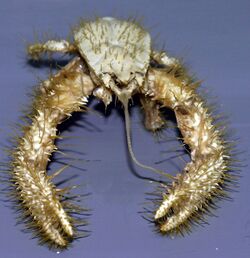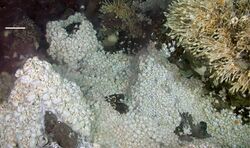Biology:Kiwa (crustacean)
| Kiwa | |
|---|---|

| |
| Kiwa hirsuta | |
| Scientific classification | |
| Domain: | Eukaryota |
| Kingdom: | Animalia |
| Phylum: | Arthropoda |
| Class: | Malacostraca |
| Order: | Decapoda |
| Suborder: | Pleocyemata |
| Infraorder: | Anomura |
| Superfamily: | Chirostyloidea |
| Family: | Kiwaidae Macpherson, Jones & Segonzac, 2006 |
| Genus: | Kiwa Macpherson, Jones & Segonzac, 2006 |
Kiwa is a genus of marine decapods living at deep-sea hydrothermal vents and cold seeps. The animals are commonly referred to as "yeti lobsters" or "yeti crabs”, after the legendary yeti, because of their "hairy" or bristly appearance.[1] The genus is placed in its own family, Kiwaidae, in the superfamily Chirostyloidea.[2]
Four species have been described: Kiwa hirsuta discovered in 2005 on the Pacific-Antarctic Ridge,[1] Kiwa puravida discovered in 2006 at cold seeps in the East Pacific (all other species are from hydrothermal vents),[3][4] Kiwa tyleri, known colloquially as the "Hoff crab", from the East Scotia Ridge,[5][6] and Kiwa araonae from the Australian-Antarctic Ridge.[7] Two similar but undescribed species are known from vents on the South West Indian Ridge and at the Galápagos respectively.[4][8] Analysis of DNA has confirmed the distinction of the species, them having diverged from each other millions of years ago.[4][6] The third undescribed species of Kiwa was discovered in 2010 in the Atlantic sector of the Southern Ocean at vents on the East Scotia Ridge. Compared with the first two species, it has proportionally much shorter chelae, with the majority of the bacteria-growing setae concentrated on the ventral carapace.[9][6]
Kiwa araonae's discovery added about 6,500 kilometers to the Kiwaidae's known range on mid-ocean ridges. From morphological observations and molecular phylogenetic investigations, K. araonae and K. puravida are closely related. Although K. araonae and K. puravida are separated by around 12,000 kilometers, they are similar. [10]
Based on the presence of sulphur-oxidising bacteria on the setae of both K. hirsuta and the new South West Indian Ridge species, they may both feed on bacteria in addition to scavenging.[6] For K. puravida, the bacteria have been identified and the feeding behaviour observed, as well as a cyclical rhythmic motion of the crab documented that is suspected to increase the flow of methane and hydrogen sulfide, the bacterial food, towards the bacteria.[3] The two sexes of the new South West Indian Ridge species prefer different temperatures, with males seeming to prefer warmer water and egg-carrying females and juveniles preferring the coldest.[6] Chemosynthetic bacteria is growing which is affecting the habitat for Yeti Crabs
The genus Kiwa is named after the god of shellfish in Polynesian mythology.[1]
Internal anatomy
Internal anatomy has been studied in Kiwa puravida.[11]
Digestive system: The stomach (gastric mill + pylorus) is situated in the upper anterior portion of the cephalothorax. The gut extends as a tube to the telson. A pair of short anterior ceca emanates from the transition between pylorus and gut, appearing as short tubes. The hepatopancreas fills most of the cephalothorax and parts of the pleon and is formed by two bunches of tubular diverticles which are each connected to the pylorus via a main duct. The stomach is embedded ventrally by the hepatopancreas whose anterior diverticles reach into the rostrum.
Antennal glands: The antennal glands are flatenned and located anterolaterally in the cephalothorax, near the second antennae. the lobes of the antennal bladder are situated anteriorly and laterally to the stomach and cover a large portion of the hepatopancreas.
Reproductive system: The testes are paired and restricted to the cephalothorax. They are connected to the vasa deferentia on each side which run to the gonopores on the coxae of the eighth thoracic segment.
Nervous system: The brain is the anteriormost part of the central nervous system. It is relatively small compared to the rest of the body. Emanating from the brain several nerves run to the sensory organs (eyes, antennulae, antennae). A pair of circumesophageal ("surrounding the esophagus") connectives connect the brain with the cephalothoracic ganglion. The latter is a compaction of several neuromeres in the lower part of the anterior cephalothorax. These neuromeres correspond morphologically with the body segments of the mandibles and the 1st and 2nd maxillae, the thoracic segments I-VIII and the first pleonal segment. The 2nd to 6th pleonal neuromeres form separate ganglia. They are arranged in an irregular segmental pattern with the sixth pleonal segment reaching into the sixth pleonal segment.
Circulatory system: The heart is located in the upper portion of the cephalothorax below the carapace and above the anterior portion of the gut. The heart is suspended by several ligaments within the pericardial sinus which is bordered by the pericardial septum. Three pairs of openings (ostia) connect sinus and interior heart space. The interior heart is crossed by asymmetrical arranged muscular bundles which are part of the heart muscle (myocard). Seven arteries which can be categorized into five artery systems (two paired, three unpaired) emanate from the heart and run to the respective organs and body regions. After having left the arteries and having washed around the tissues the "blood" (hemolymph) is channelled to the gill (branchial) sinus via crevices (lacunae) and channels (sinus). After its oxygenation the hemolymph is returning to the pericardial sinus via the branchio-pericardial sinus.
Muscle systems: The general structure and organization of the various muscle systems in Kiwa (puravida) is congruent with that of other decapods.
References
- ↑ 1.0 1.1 1.2 "A new squat lobster family of Galatheoidea (Crustacea, Decapoda, Anomura) from the hydrothermal vents of the Pacific-Antarctic Ridge". Zoosystema 27 (4): 709–723. 2006. http://www.mnhn.fr/museum/front/medias/publication/6892_z05n4a3.pdf.
- ↑ "Galatheoidea are not monophyletic - molecular and morphological phylogeny of the squat lobsters (Decapoda: Anomura) with recognition of a new superfamily". Molecular Phylogenetics and Evolution 58 (2): 157–68. February 2011. doi:10.1016/j.ympev.2010.11.011. PMID 21095236.
- ↑ 3.0 3.1 "Dancing for food in the deep sea: bacterial farming by a new species of Yeti crab". PLOS ONE 6 (11): e26243. 2011. doi:10.1371/journal.pone.0026243. PMID 22140426. Bibcode: 2011PLoSO...626243T.
- ↑ 4.0 4.1 4.2 "A new yeti crab phylogeny: Vent origins with indications of regional extinction in the East Pacific". PLOS ONE 13 (3): e0194696. 2018. doi:10.1371/journal.pone.0194696. PMID 29547631. Bibcode: 2018PLoSO..1394696R.
- ↑ Amos, Jonathan (2015-06-25). "'Hoff crab' gets formal scientific name". BBC News. https://www.bbc.co.uk/news/science-environment-33263621.
- ↑ 6.0 6.1 6.2 6.3 6.4 "The discovery of new deep-sea hydrothermal vent communities in the southern ocean and implications for biogeography". PLOS Biology 10 (1): e1001234. January 2012. doi:10.1371/journal.pbio.1001234. PMID 22235194.
- ↑ "A new species of yeti crab, genus Kiwa Macpherson, Jones and Segonzac, 2005 (Decapoda: Anomura: Kiwaidae), from a hydrothermal vent on the Australian-Antarctic Ridge". Journal of Crustacean Biology 36 (2): 238–247. 2016. doi:10.1163/1937240x-00002418.
- ↑ Rebecca Morelle (December 28, 2011). "Deep-sea creatures at volcanic vent". BBC News. https://www.bbc.co.uk/news/science-environment-16267625.
- ↑ "The biogeography of the yeti crabs (Kiwaidae) with notes on the phylogeny of the Chirostyloidea (Decapoda: Anomura)". Proceedings. Biological Sciences 280 (1764): 20130718. August 2013. doi:10.1098/rspb.2013.0718. PMID 23782878.
- ↑ Lee, S.-H., Lee, W.-K., & Won, Y.-J. (2016). A New Species of Yeti Crab, Genus Kiwa Macpherson, Jones and Segonzac, 2005 (Decapoda: Anomura: Kiwaidae), from a Hydrothermal Vent on the Australian-Antarctic Ridge. Journal of Crustacean Biology, Volume 36 (Issue 2), Page numbers 238-247. Goffredi, S. K., Gregory, A., Jones, W. J., Morella, N. M., & Sakamoto, R. I. (2014). Ontogenetic variation in epibiont community structure in the deep-sea yeti crab, Kiwa puravida: Convergence among crustaceans. Molecular Ecology, Volume 23 (Issue 6), Page numbers 1457-1472.
- ↑ Keiler, Jonas; Richter, Stefan; Wirkner, Christian S. (2016). "Revealing their innermost secrets: an evolutionary perspective on the disparity of the organ systems in anomuran crabs (Crustacea: Decapoda: Anomura)". Contributions to Zoology 85 (4): 361–386. doi:10.1163/18759866-08504001.
External links
Wikidata ☰ {{{from}}} entry
 |


